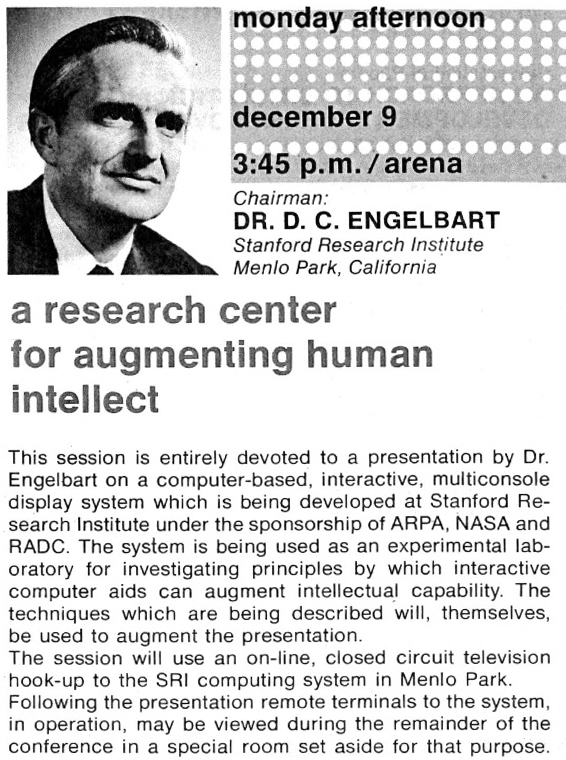I was able to go to the 40th Anniversary celebration of “The Mother of All Demos.” The 1968 live demo is most famous for introducing its hardware, including the mouse, but it was quite a bit more than that…

The list of physical advancements was an impressive catalog of what we would gradually aspire to over the next 40 years. In addition to a keyboard (rather than punch cards), Doug Englebart showed off a mouse and a special one-handed chorded keyboard. His interaction speed was a bit faster even than what people experience with today’s personal computers. He used a Cathode Ray Tube (rather than a teletype), with black-on-white text and graphics (rather than white on green text-only). The demo involved multiple people working simultaneously on the same application (two live mouse pointers were visible simultaneously) with the participants separated by 30 miles, and visible to each other through embedded realtime streaming video. (The latter was achieved with television cameras, transmission, and mixers.)
The software was even more advanced. The users could instantly reach into the middle of a document in a shared information space, showing only the requested information, and drilling down or out to reveal more. All could be inter-linked together, as when Englebart showed a map of his his route home and brought up his shopping list for individual stops along the way. At a time when software was all about processing data, I don’t think there was a single number shown in the whole demo (except as part of command names and outline node numbers).
More generally, Englebart was showing us how computers could be used interactively, in real time, with other people. Compared with the batch computing of the time, it has taken 40 years to widely deploy just the “personal computer” aspect of this: interactive performance for one person working with one application at a time. But The Demo that was “The Dawn of Interactive Computing” actually showed both multiple people working simultaneously with the same applications, and fluid applications working with each other. This breadth of interactivity has been absent all this time, and only the latest tools (like Qwaq Forums, for example) are deploying this widely for ordinary users.
Even more generally, Englebart showed us how to develop technical advances on this magnitude and time scale, just as Demming showed how to develop on an industrial scale. The demo was so far ahead of its time that an entirely new way of doing development had to be invented. We now take for granted that new tools should be used to develop themselves in pilot projects: to “keep it real” for the developers; to empower developers with the compound productivity afforded by the tools’ new capabilities; to create a community of users through which the tools will be both redefined and spread; and to co-evolve both tools and community. (A fun bit of trivia for me was that Englebart called these communities QWAC — Knowledge Workshop Architect’s Community.)
Underlying this approach was a vision of augmenting human performance primarily by letting technology do the things that technology is good at, in order to help people work together. This contrasts with a common big-project goal of automating activity that people are good at and which machines are not. (I had not appreciated how much Alan Kay was Englebart’s heir. Alan gave a terrific keynote comparing the use of technology for augmentation vs as a prosthetic, particularly when the crutch is replacing a capability that we already have.)
I was not surprised to hear that Englebart’s lifelong work was inspired by Vannevar Bush’s famous “As We May Think” article. But I had not realized that Englebart had been particularly intrigued by Bush’s description of flying through an information space. Twenty years ago I had read that description as being an abstract metaphor, not the literal interpretation afforded by virtual worlds like Forums.
Although I am biased, I was both surprised and excited that so many of the presenters and audience seemed to me to be in agreement that the great “what’s next” area was surely in deep collaboration — multiple applications at once and multiple people using them at once — the precise area of my own work.



